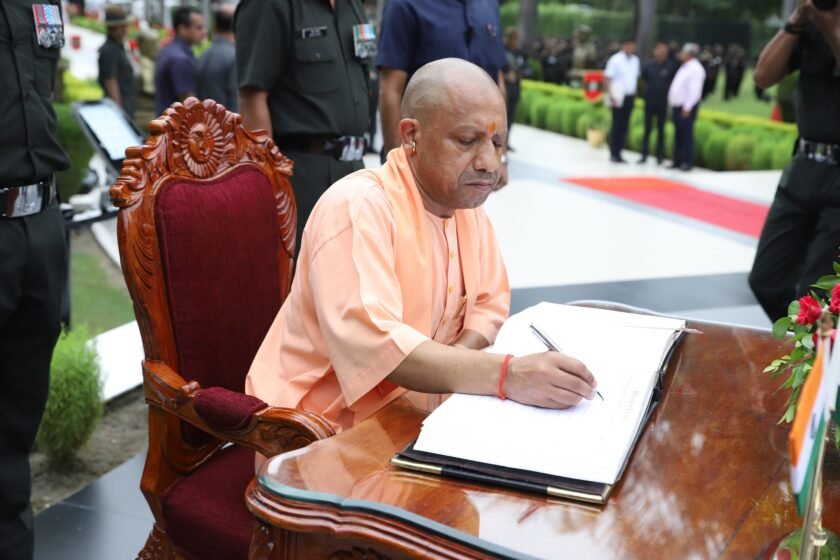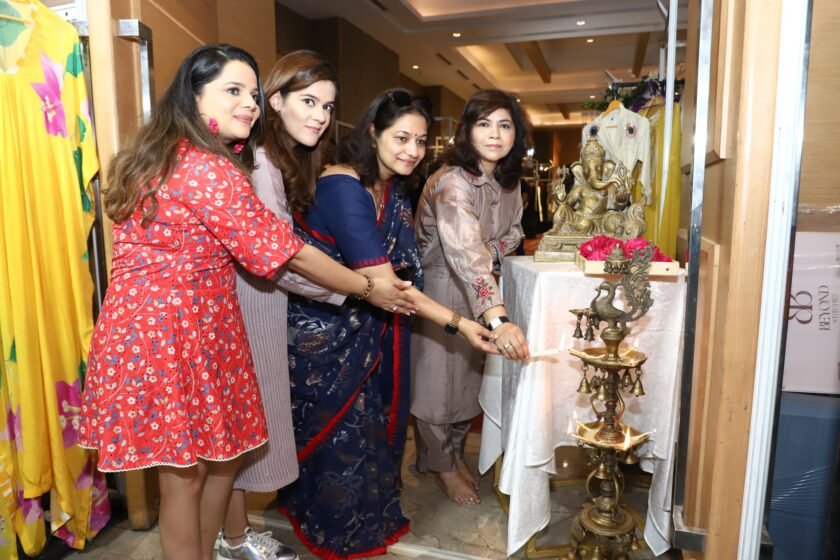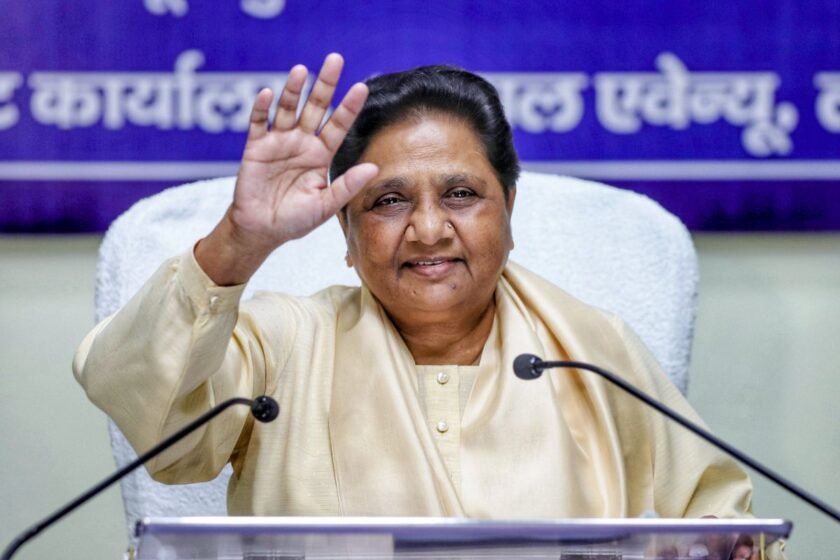Lucknow: On Sunday was the second day of the workshop.
Madhavi Kuckreja said, “Until you learn it, you can’t truly appreciate it. There is so much tension in picking up each thread. You need to understand its intricacies and recognize the craft, so that when you go to the market, you can evaluate it properly.”
Munnawar who is an artisan conducting the workshop said, “ I have been doing this for the past 30 years. Nine people sitting on the adda and working on a single shawl with zardozi work will take around 2 months to complete. The craft of zardozi is very intricate and needs to be preserved.”
Zardōzī, or kārcōb, is embroidery using metal wires like salmā, sitārā, kōrā, and dabkā, along with beads and stones, to create elaborate patterns on fabric.
Participants were from the Sanatkada team and from outside.
In this workshop, participants learnt the fundamentals of handling embroidery threads and also creating designs using both zardōzī and ārī techniques, including popular motifs like flowers, paisleys, and birds.
Filmistaan ( Film screening and discussion)
A series of films were screened on Costumes and Crafts of Lucknow by the Sanatkada Film Studio which was followed by a discussion.
Artisan Abdullah’s son, Shahnawaaz was present in the film screening and he said, “ Kaam toh badh raha hai. Abhi tak logo ko pata nahi hai, woh parakh nahi paate. Ache kaam ko kharab kardiya.Woh karigari ko nahi pehchan paate hai”
Abdullah’s son, Shahnawaaz, adn artisan himself said, “ Mujhe ye films dekh ke bahaut acha laga. Mujhe ye dekh ke bahaut acha lag raha hai ki in films se Lucknow Bioscope ye kaarigar aur craft ko zinda rakh raha hai.Kaamdani pehle revive kia tha tarun tahiliani ne, lara Dutta ne Femina ke cover main pehna tha.”
Films screened:
Film- Chatapati/Tukdi Gharara – “Tukdi” means pieces and in terms of tukdi work done on different attires involves cutting of colourful fabric in different patterned pieces stitched together to make an attire or dress like gharara, lehenga etc. It is a time taking and delicate craft that requires precision and efficiency.Zeenat from Lucknow is one of the two artisans left, and in this video, she takes us through a detailed journey of tukdi work while discussing the difficulties and challenges that she and this art form face today.
Film – “Sari nahi, Virasat hai” – In this film, Purva Naresh, a playwright, film and theatre producer from Lucknow talks about her maternal grand-mother’s collection of old sarees.
Film-: “Leheriya Dupatta” – The film talks about the many aspects and traditions of Lucknow that were once practiced at homes for generations, escaping the commercialisation that is met with an art-form. One such practice of dyeing ‘Dupattas’ (long scarves thrown over shoulders) in different patterns by women at homes is on the verge of dying with only a handful women still practicing.
Film – “ Khandani Libas” – Noor Khan is an educationist and retired as a Principal of Karamat Husain College, Lucknow. In this film, she along with her daughter and grand-daughter shows us some traditional pieces like gharara, saree, dupatta etc. passed down from generations. She tells the story and origin of each and helps us dive deep into the culture and tradition of Lucknow.
Film – “ Chandi ki Chappal” – In this film, Lucknow Bioscope has documented the process of naqqashi on chappals or slippers as this practice is native to Lucknow. Jawwar Hussain whose family has been practicing this craft for generations, couldn’t continue with this work a year after the documentation video was shot due to lack of proper and continuous income.
Film- “ Kaamdani” – Kaamdani”, another embroidery art that is native to Lucknow was traditionally done using flattened wires of silver and gold, weaved through fabric to make intricate patterns and designs. Nowadays, it is mostly done using copper wires that are polished with silver. In this film, Mr. Abdullah, an artisan from Lucknow explains different types of stitches and the process of making a finished Kaamdani product which takes months to finish.
The second event of the day was a talk by Dr. Veena Oldenburg, “Searching Traces of Lucknow in memory of People and the Archive”.
Dr. Veena Oldenburg : Dr. Veena Oldenburg is a native of Lucknow, India and subsequently lived in Gurgaon, India.She is a Professor of History at Baruch College and The Graduate Center of the City University of New York. She has done pioneering work on colonial Lucknow.The Making of Colonial Lucknow, 1856-1877 , Lifestyle as resistance: the case of the courtesans of Lucknow and Dowry murder : the imperial origins of a cultural crime. She is also committed to gender equality. Women’s education is high on her list. She has several scholarly books and articles on gender & violence, and British colonialism in India. She has written about the aftermath of the Rebellion in 1857 and its effects on the city of Lucknow.She is also one of the advisors of Lucknow Bioscope.
Dr. Veena Oldenburg joined in through zoom for the talk.
Her quotes:
“ I am glad to be here albeit virtually. I wish I could be there in lucknow as a native and it is also one that I discovered as a scholar.”
“Discovering lucknow really takes a lifetime. When one is born into it we are surrounded by several cliches.I would go to several places in Lucknow and the one thing that I discovered was that there were various anecdotes that were quite often repeated in those houses.”
“Out of the various experiences, one very interesting one was when I had gone to the Toria Street.I asked people why it was named what it was named to which I didn’t receive any legible reasons.
Later on, upon looking into it more I found that the street had a small shrine devoted to Queen Victoria. Several similar streets and complexes have been named after her as well.”
“About courtesans – Once again we all in lucknow tend to have very general information about tawaifs. Begum Akhter performing mujras, her being a former tawaif etc.”
“But then this one time I found a set of letters which belonged to Nawab Wajid Ali Shah and were written in a very Persianised Urdu which I took to the Persian department. I found that whatever was written about women in those letters, tawaifs etc, it was always something about how the nawab was so upset and heartbroken about them.”
“One gentleman who read the letter told me he didn’t know the name of his father. It led me to find that his mother and grandmother used to be tawaifs. That is when I first went to the kotha and met them. Initially reluctant and suspicious of me being a government agent they did not quite trust me but over time I became a friend who shared hookas and paans with them.”
The talk was followed by the gallery walkthrough by curators, Noor Khan and Saman Habib.




